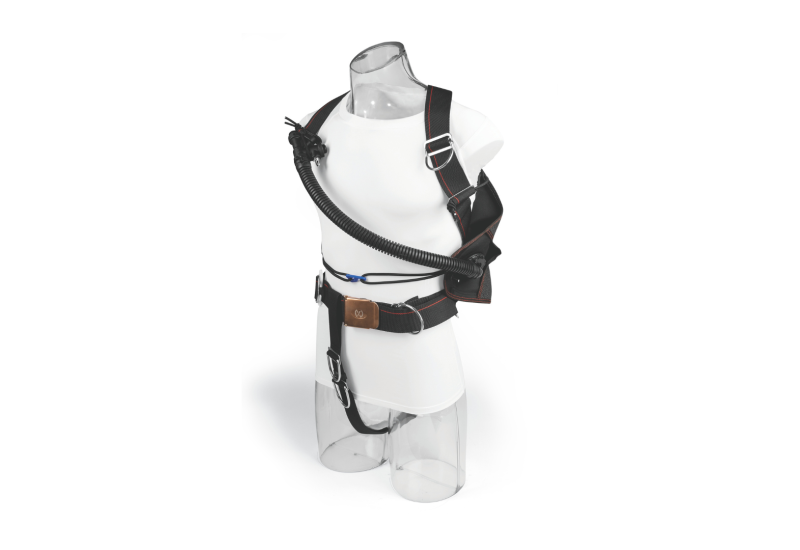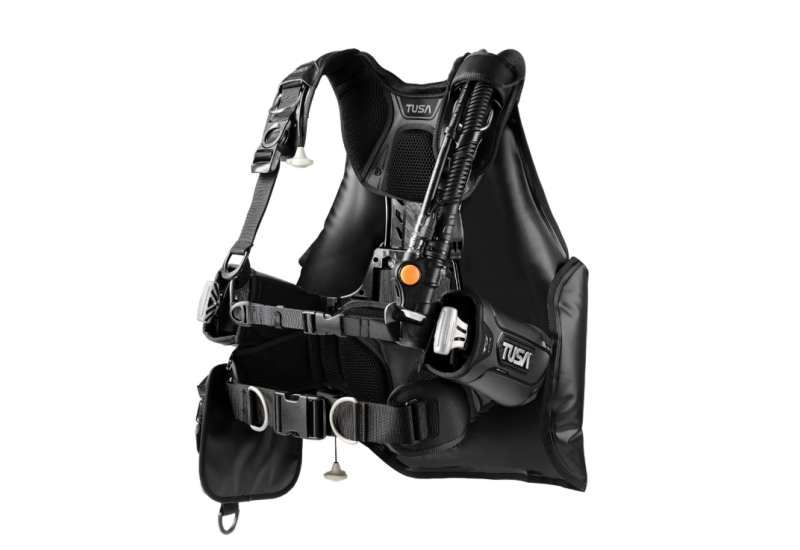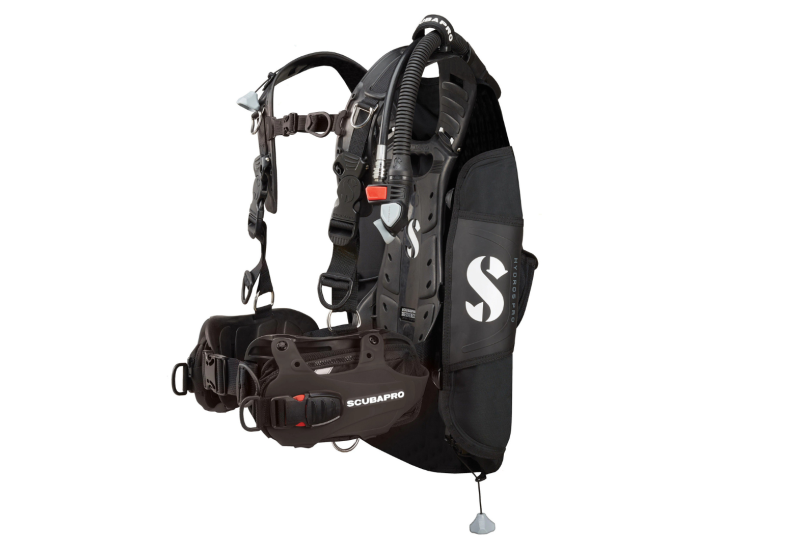ScubaLab Blog: BC Testing 2011

BC blog opener
Katy Danca Galli
Scuba Diving Gear Tests: BCs
–Text by Floyd Devine, ScubaLab Test Team Supervisor
–Photography by Katy Danca Galli and Ryan McClellan
As the regulator tests drew to a close, we set our sights on our next round of scuba gear testing: this year's newest BCs. When the boxes with the BCs arrived, it soon became apparent that logistics would be one of our biggest challenges. With eight models undergoing full testing and three others as “first look” systems (tech BCs, prototypes or “too late to test” models), we were forced to commandeer a larger office space and rent a van to handle the number of BCs — a number that seemed to grow almost daily. Unlike computers and regulators, one model of each BC wouldn’t be enough for the test, especially when we failed to find half-a-dozen men and women divers that all wear the exact same size.
Wet and Dry Tests
We began the testing by putting each BC through our “dry” lab process. Owner’s manuals and online data were examined to find out what the manufacturers wanted us to know about their products, and then we began picking things apart, putting things on and hooking them up to air supplies to get a feel for the operation of inflation systems, integrated weight systems and clips, buckles and straps. This gave us the opportunity to contact the manufacturers with any  questions or problems before any system was put in the water and pushed to its limits.
questions or problems before any system was put in the water and pushed to its limits.
Once we were finished with the dry testing, we piled one model of each new BC into Eric Michael’s (Editor of Scuba Diving’s sister publication, Sport Diver) borrowed Ford Bronco (to avoid soaking the inside of a newer vehicle – thanks, Eric!) and headed to the pool. When it comes to our objective tests, BCs win hands down for being the most fun. While regulators and computers are taken to laboratory facilities for extensive testing of their technical features, BCs are tested in a pool. Any time your office is in the water — whether it’s a pool, spring or ocean — it’s a good day at work. Three different tests were conducted on each BC: inherent buoyancy, lift capacity and inflator/valve operation.
While strapping fully inflated BCs to a bucket and filling it with weight until the BCs submerge and “hover” neutrally buoyant, along with sitting on the bottom of the pool with fully open inflation and deflation valves to see if the BC will bolt to the surface may not sound as interesting as diving the Blue Hole, it’s certainly more fun than sitting in the office dreaming about blowing bubbles.
Open-Water Tests
Having completely saturated the BCs — and our test team — with chlorinated water, we tabulated results and prepared for the next phase of our testing: subjective testing in open water. No one had a vehicle large enough to transport 30 BCs, so I was forced to rent a 12-passenger van and remove the seats in the back for our trip to the ocean.
For the open-water testing we chose Palm Beach, Florida, because of the challenging aspect of drift diving the new BCs in moderate depths and currents, the area’s incredible diversity of sea life and the fact that it is relatively close to our offices. With the location decided, we loaded up the monster rental van on a sunny Wednesday morning and headed to the beach.
Hosting us on our two-day quest for BC knowledge was Narcosis Dive Charters and its Owner/Captain, Van Blakeman. Conditions for our testing could not have been better, with great visibility and abundant marine life on the reefs, including lots of sharks and turtles. Besides the great diving, testers rated the BCs on a variety of ergonomic factors that included comfort, stability, and ease of operation of the inflator assembly, valves and integrated weight systems. After two days of intense scrutiny, the test team compiled their notes over crab dip and tropical libations from the local tiki bar, and rated the BCs in each of six ergonomic categories. (Check out Dan Volker’s video of the testing at http://youtu.be/aSykvuuuV2o)
Final Results
Satisfied that we left no buckle unclipped, we loaded everything back into the monster van and headed back home to Orlando. To see the final results of our BC tests, pick up the August issue of Scuba Diving, or check back to scuabdiving.com later this week.
–Floyd Devine is the Testing Supervisor for ScubaLab and a self-professed “gear head.” A retired naval officer who has been diving the world’s oceans for 22 years, Floyd is a PADI MSDT, NAUI Divemaster, DAN instructor and equipment repair technician.
Special thanks to:
–Narcosis Dive Charters (www.narcosisdivecharters.com), Captain Van Blakeman and his crew for doing a fantastic job of managing both divers and a mountain of equipment over the two days of diving off Palm Beach.
Our test team, a diverse mix of seasoned industry professionals and younger, but extremely competent and well trained, dive enthusiasts and instructors, including:
–Tec Clark is a dive industry professional with 20 years experience in instructor development. His dive industry background includes positions as Managing Director of the University of Florida Academic Diving Program, Captain of the U.S. Freediving Team, and National Director of the YMCA Scuba Program. Tec is currently the director of Reef Ministries as well as the founder and host of ScubaGuru.com a new tips and advice website for divers and instructors.
–Evan Culbertson gained his initial NAUI certification at Coastal Carolina University in 2006 and cut his teeth in the cool Atlantic waters from the Carolinas up to the Chesapeake Bay. Most of his Florida diving has been in the aquariums of the three SeaWorld parks in Orlando and the area’s freshwater springs. An avid spear fisherman and reef conservationist, he has a deep concern for the health of the state’s reefs and is currently living the mantra: “remove a lion fish, save a reef.”
–Katy Danca Galli is the Photo Editor of Scuba Diving magazine and is just beginning her exploration of underwater photography. She has been diving for 8 years, is a NAUI master diver, and has served as a volunteer Asst. Instructor with a youth-based scuba program out of Cape Coral for the past 5 years.
–Scott Hiltsley is a full-time, career fireman/EMT with the Orlando (FL) Fire Department. Scuba certified since 1995, Scott is trained in Dive and Surface Water Rescue. Scott has been a PADI Divemaster since 2004 and works part time in a local dive shop to keep his finger on the pulse of the dive industry. His favorite dives usually include wrecks or walls, but don’t be afraid to throw him overboard for a leisurely drift dive on one of Florida’s fabulous reefs! Scott is quickly approaching the 1000 dive milestone and working on his OW Instructor certification.
–H. Kelly Levendorf has been instructing since 1982. He is a Master Instructor, who has certified more than 500 divers, from OW through Assistant Instructor. He is also an experienced technical diver, TDI-SDI and IANTD Instructor, and PFI-certified Freediver.
–Ryan McClellan, PADI Divemaster and award-winning UW photographer and videographer, Ryan is the former Director of Media at Pro Dive International. Now the owner of Born of Water (www.bornofwater.com), Ryan develops and markets eco-friendly water sports apparel.
–Nikole Ordway’s love of diving began in San Diego, Calif., and continued to grow as she worked as a research diver, a diver for the U.S. Navy's Marine Mammal Program and a PADI Instructor. Nikole has a degree in Biology, is a Coast Guard licensed Captain, and is a Course Director for Reef Check. Currently working for Force-E Dive Centers in South Florida, she is enjoying the warm tropical waters and sharing her love of diving with others.
–Erin Porter's life changed the moment she took her first breaths underwater in 2002. She earned her PADI IDC Staff Instructor certification in the kelp beds of San Diego before finding her way to the tropical waters of Florida. She loves sharing the joy of diving with students and experiencing those moments of awe every time she submerges beneath the surface.
–Marissa Wiganowske has an undergraduate and graduate degree from Barry University in Sports Management-Dive Industry. A PADI MSDT and dedicated shark conservationist, Marissa is the East Coast representative for Pegasus Thruster DPVs and enjoys blowing her hair back in the Formula H20 DPV Racing series.
–Samantha Whitcraft, PADI Instructor and frequent contributor to Scuba Diving, is a former University of Miami Senior Research Associate under contract to NOAA, with worldwide recreational and scientific diving experience. She is now Adjunct Faculty for Miami-Dade College and the Conservation Biologist for Shark Savers. In addition to her diving abilities, Sam’s scientific background was “volunteered” to coordinate the data-crunching portion of the testing.

Katy Danca Galli
Scuba Diving Gear Tests: BCs
–Text by Floyd Devine, ScubaLab Test Team Supervisor
–Photography by Katy Danca Galli and Ryan McClellan
As the regulator tests drew to a close, we set our sights on our next round of scuba gear testing: this year's newest BCs. When the boxes with the BCs arrived, it soon became apparent that logistics would be one of our biggest challenges. With eight models undergoing full testing and three others as “first look” systems (tech BCs, prototypes or “too late to test” models), we were forced to commandeer a larger office space and rent a van to handle the number of BCs — a number that seemed to grow almost daily. Unlike computers and regulators, one model of each BC wouldn’t be enough for the test, especially when we failed to find half-a-dozen men and women divers that all wear the exact same size.
Wet and Dry Tests
We began the testing by putting each BC through our “dry” lab process. Owner’s manuals and online data were examined to find out what the manufacturers wanted us to know about their products, and then we began picking things apart, putting things on and hooking them up to air supplies to get a feel for the operation of inflation systems, integrated weight systems and clips, buckles and straps. This gave us the opportunity to contact the manufacturers with any  questions or problems before any system was put in the water and pushed to its limits.
questions or problems before any system was put in the water and pushed to its limits.
Once we were finished with the dry testing, we piled one model of each new BC into Eric Michael’s (Editor of Scuba Diving’s sister publication, Sport Diver) borrowed Ford Bronco (to avoid soaking the inside of a newer vehicle – thanks, Eric!) and headed to the pool. When it comes to our objective tests, BCs win hands down for being the most fun. While regulators and computers are taken to laboratory facilities for extensive testing of their technical features, BCs are tested in a pool. Any time your office is in the water — whether it’s a pool, spring or ocean — it’s a good day at work. Three different tests were conducted on each BC: inherent buoyancy, lift capacity and inflator/valve operation.
While strapping fully inflated BCs to a bucket and filling it with weight until the BCs submerge and “hover” neutrally buoyant, along with sitting on the bottom of the pool with fully open inflation and deflation valves to see if the BC will bolt to the surface may not sound as interesting as diving the Blue Hole, it’s certainly more fun than sitting in the office dreaming about blowing bubbles.
Open-Water Tests
Having completely saturated the BCs — and our test team — with chlorinated water, we tabulated results and prepared for the next phase of our testing: subjective testing in open water. No one had a vehicle large enough to transport 30 BCs, so I was forced to rent a 12-passenger van and remove the seats in the back for our trip to the ocean.
For the open-water testing we chose Palm Beach, Florida, because of the challenging aspect of drift diving the new BCs in moderate depths and currents, the area’s incredible diversity of sea life and the fact that it is relatively close to our offices. With the location decided, we loaded up the monster rental van on a sunny Wednesday morning and headed to the beach.
Hosting us on our two-day quest for BC knowledge was Narcosis Dive Charters and its Owner/Captain, Van Blakeman. Conditions for our testing could not have been better, with great visibility and abundant marine life on the reefs, including lots of sharks and turtles. Besides the great diving, testers rated the BCs on a variety of ergonomic factors that included comfort, stability, and ease of operation of the inflator assembly, valves and integrated weight systems. After two days of intense scrutiny, the test team compiled their notes over crab dip and tropical libations from the local tiki bar, and rated the BCs in each of six ergonomic categories. (Check out Dan Volker’s video of the testing at http://youtu.be/aSykvuuuV2o)
Final Results
Satisfied that we left no buckle unclipped, we loaded everything back into the monster van and headed back home to Orlando. To see the final results of our BC tests, pick up the August issue of Scuba Diving, or check back to scuabdiving.com later this week.
–Floyd Devine is the Testing Supervisor for ScubaLab and a self-professed “gear head.” A retired naval officer who has been diving the world’s oceans for 22 years, Floyd is a PADI MSDT, NAUI Divemaster, DAN instructor and equipment repair technician.
Special thanks to:
–Narcosis Dive Charters (www.narcosisdivecharters.com), Captain Van Blakeman and his crew for doing a fantastic job of managing both divers and a mountain of equipment over the two days of diving off Palm Beach.
Our test team, a diverse mix of seasoned industry professionals and younger, but extremely competent and well trained, dive enthusiasts and instructors, including:
–Tec Clark is a dive industry professional with 20 years experience in instructor development. His dive industry background includes positions as Managing Director of the University of Florida Academic Diving Program, Captain of the U.S. Freediving Team, and National Director of the YMCA Scuba Program. Tec is currently the director of Reef Ministries as well as the founder and host of ScubaGuru.com a new tips and advice website for divers and instructors.
–Evan Culbertson gained his initial NAUI certification at Coastal Carolina University in 2006 and cut his teeth in the cool Atlantic waters from the Carolinas up to the Chesapeake Bay. Most of his Florida diving has been in the aquariums of the three SeaWorld parks in Orlando and the area’s freshwater springs. An avid spear fisherman and reef conservationist, he has a deep concern for the health of the state’s reefs and is currently living the mantra: “remove a lion fish, save a reef.”
–Katy Danca Galli is the Photo Editor of Scuba Diving magazine and is just beginning her exploration of underwater photography. She has been diving for 8 years, is a NAUI master diver, and has served as a volunteer Asst. Instructor with a youth-based scuba program out of Cape Coral for the past 5 years.
–Scott Hiltsley is a full-time, career fireman/EMT with the Orlando (FL) Fire Department. Scuba certified since 1995, Scott is trained in Dive and Surface Water Rescue. Scott has been a PADI Divemaster since 2004 and works part time in a local dive shop to keep his finger on the pulse of the dive industry. His favorite dives usually include wrecks or walls, but don’t be afraid to throw him overboard for a leisurely drift dive on one of Florida’s fabulous reefs! Scott is quickly approaching the 1000 dive milestone and working on his OW Instructor certification.
–H. Kelly Levendorf has been instructing since 1982. He is a Master Instructor, who has certified more than 500 divers, from OW through Assistant Instructor. He is also an experienced technical diver, TDI-SDI and IANTD Instructor, and PFI-certified Freediver.
–Ryan McClellan, PADI Divemaster and award-winning UW photographer and videographer, Ryan is the former Director of Media at Pro Dive International. Now the owner of Born of Water (www.bornofwater.com), Ryan develops and markets eco-friendly water sports apparel.
–Nikole Ordway’s love of diving began in San Diego, Calif., and continued to grow as she worked as a research diver, a diver for the U.S. Navy's Marine Mammal Program and a PADI Instructor. Nikole has a degree in Biology, is a Coast Guard licensed Captain, and is a Course Director for Reef Check. Currently working for Force-E Dive Centers in South Florida, she is enjoying the warm tropical waters and sharing her love of diving with others.
–Erin Porter's life changed the moment she took her first breaths underwater in 2002. She earned her PADI IDC Staff Instructor certification in the kelp beds of San Diego before finding her way to the tropical waters of Florida. She loves sharing the joy of diving with students and experiencing those moments of awe every time she submerges beneath the surface.
–Marissa Wiganowske has an undergraduate and graduate degree from Barry University in Sports Management-Dive Industry. A PADI MSDT and dedicated shark conservationist, Marissa is the East Coast representative for Pegasus Thruster DPVs and enjoys blowing her hair back in the Formula H20 DPV Racing series.
–Samantha Whitcraft, PADI Instructor and frequent contributor to Scuba Diving, is a former University of Miami Senior Research Associate under contract to NOAA, with worldwide recreational and scientific diving experience. She is now Adjunct Faculty for Miami-Dade College and the Conservation Biologist for Shark Savers. In addition to her diving abilities, Sam’s scientific background was “volunteered” to coordinate the data-crunching portion of the testing.










